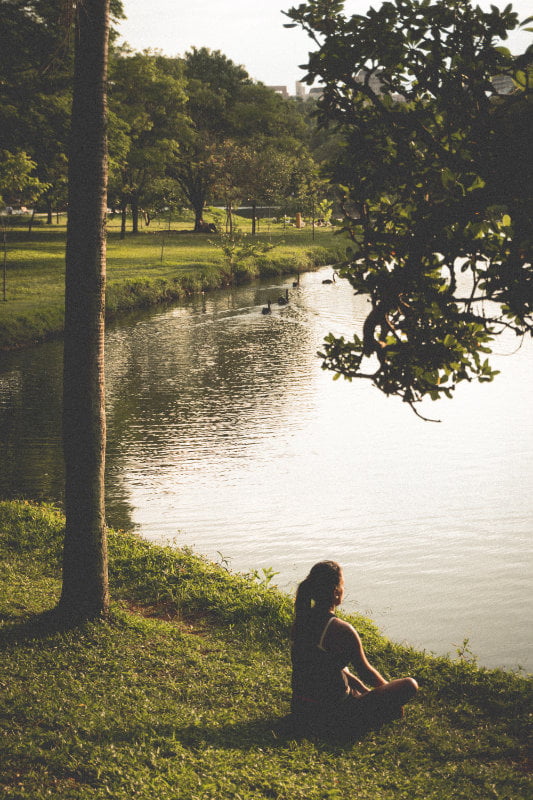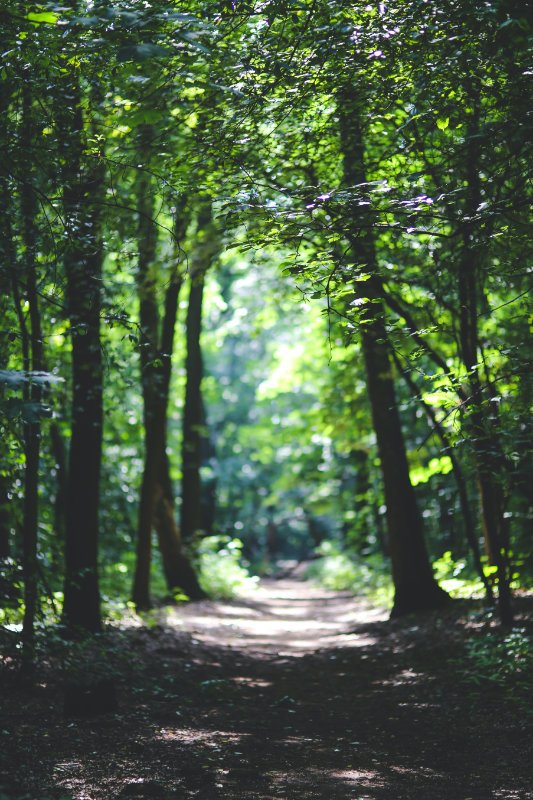In today’s fast-paced world, it’s easy to feel this anxious, stressed and overwhelmed. With constant notifications, deadlines, and pressures, it’s no wonder stress levels are on the rise.
But what if I told you there’s a simple and natural way to reduce stress?
Spending time outdoors in nature has been shown to have a calming effect on the mind and body.
This post explores nature’s calming effect and how to incorporate nature into your daily routine.
The Science Behind Nature’s Calming Effect
Numerous studies have shown that spending time in nature can reduce stress levels.
One study found that spending just 20 minutes in a park can lower cortisol levels, a hormone associated with stress [1].
Another study found that people who walked in nature had lower levels of rumination, a pattern of negative thinking that can contribute to anxiety and depression [2].
Additionally, being in nature has been shown to improve mood, increase feelings of vitality, and decrease symptoms of depression [3] [4].
So why does nature have this effect on us?
There are a few theories.
One theory suggests that nature provides an opportunity for us to detach ourselves from the constant stimulation of contemporary lifestyles. When surrounded by trees, birds, and other natural elements, our brains can relax and focus on the present moment.
Another theory is that nature has a restorative effect on our attentional capacity, allowing us to focus better and concentrate [5].

Incorporating Nature Into Your Daily Routine
Now that we know the benefits of spending time in nature, how can we incorporate it into our daily routine?
Here are a few ideas:
Take a relaxing walk outside during your lunch break.
Instead of staying at your desk or scrolling through social media, getting outside for just 10 minutes can significantly impact your mood and overall well-being.
The fresh air and sunshine help to clear your mind and improve your focus, making it a bit easier to tackle the rest of your day.
Additionally, walking is a form of exercise which has been shown to reduce stress levels and improve mental health.
Plan a weekend hike or camping trip.
The presence of natural elements, natural beauty and fresh air can contribute to reducing stress levels and promoting relaxation.
Engaging in activities such as walking, hiking, and camping can benefit physical and mental health, as they can stimulate the production of endorphins and improve mood.
Also, spending time in nature has been shown to improve sleep quality, which can also help to reduce stress levels.
There are numerous fun and enjoyable outdoor activities available that can assist in rejuvenating and resetting oneself, regardless of whether you opt for a relaxed stroll or a demanding ascent.
So, if you’re feeling stressed or overwhelmed, consider planning a weekend getaway to a nearby park or wilderness area and experience nature’s calming effect.
Start an outside garden or tend to indoor plants.
Even if you don’t have access to a park or hiking trail, you can still bring nature into your daily life by tending to indoor plants.
Incorporating indoor plants into your living space adds a touch of greenery and has been proven to enhance air quality and lower stress levels.
Gardening can be meditative and calming, providing a sense of purpose and accomplishment as you care for your plants.

Diverse Perspectives on Nature’s Calming Effect
Nature has been shown to impact our mental health and well-being positively, but it’s essential to acknowledge that not everyone has equal access to nature.
People who live in urban areas or low-income neighbourhoods may not have easy access to parks or green spaces, which can limit their ability to experience the calming effects of nature. This lack of access to nature can contribute to higher levels of stress and anxiety, and other health issues.
Additionally, people with disabilities may face barriers to accessing nature. Many parks and outdoor areas are not constructed with features that cater to individuals with mobility impairments or disabilities, which can create obstacles for them to reap the advantages of being in nature. This lack of accessibility can contribute to feelings of isolation, exclusion, and physical and mental health issues.
We must acknowledge these disparities and make nature accessible to everyone. This can involve a variety of efforts by communities and governments, including creating more green spaces in urban areas, providing funding for park maintenance and improvements, and designing outdoor spaces to be more accessible for people with disabilities.
There are also ways that individuals can work to make nature more accessible. This can involve advocating for more green spaces in your community, volunteering with local environmental organisations, or simply taking the time to appreciate and care for the natural world around you.
By working together to make nature more accessible, we can help ensure that everyone can experience nature’s calming effect, regardless of their background or circumstances.
Final Thoughts
Spending time in nature has been shown to have a powerful and positive effect on our mental health and well-being.
Whether taking a walk in the park, going for a hike, or simply tending to indoor plants, incorporating nature into our daily lives can help us feel more relaxed, focused, and content.
So next time you’re feeling frazzled, take a deep breath, step outside, and let the calming power of nature work its magic.
References
[1] Hunter, M.R., Gillespie, B.W. and Chen, S.Y.-P. (2019). Urban Nature Experiences Reduce Stress in the Context of Daily Life Based on Salivary Biomarkers. Frontiers in Psychology, [online] 10(1). doi:https://doi.org/10.3389/fpsyg.2019.00722.
[2] Bratman, G.N., Hamilton, J.P., Hahn, K.S., Daily, G.C. and Gross, J.J. (2015). Nature experience reduces rumination and subgenual prefrontal cortex activation. Proceedings of the National Academy of Sciences, [online] 112(28), pp.8567–8572. doi:https://doi.org/10.1073/pnas.1510459112.
[3] Ward Thompson, C., Roe, J., Aspinall, P., Mitchell, R., Clow, A. and Miller, D. (2012). More green space is linked to less stress in deprived communities: Evidence from salivary cortisol patterns. Landscape and Urban Planning, 105(3), pp.221–229. doi:https://doi.org/10.1016/j.landurbplan.2011.12.015.
[4] Barton, J. and Pretty, J. (2010). What is the Best Dose of Nature and Green Exercise for Improving Mental Health? A Multi-Study Analysis. Environmental Science & Technology, [online] 44(10), pp.3947–3955. doi:https://doi.org/10.1021/es903183r.
[5] Bratman, G.N., Anderson, C.B., Berman, M.G., Cochran, B., de Vries, S., Flanders, J., Folke, C., Frumkin, H., Gross, J.J., Hartig, T., Kahn, P.H., Kuo, M., Lawler, J.J., Levin, P.S., Lindahl, T., Meyer-Lindenberg, A., Mitchell, R., Ouyang, Z., Roe, J. and Scarlett, L. (2019). Nature and mental health: An ecosystem service perspective. Science Advances, 5(7). doi:https://doi.org/10.1126/sciadv.aax0903.
Images Used
Photo by Johannes Plenio: https://www.pexels.com/photo/forest-covered-in-white-fog-1423600/
Photo by Kaboompics .com: https://www.pexels.com/photo/the-path-among-the-trees-6037/
Photo by Kaique Rocha: https://www.pexels.com/photo/woman-sitting-on-grass-by-lake-290627/





0 Comments